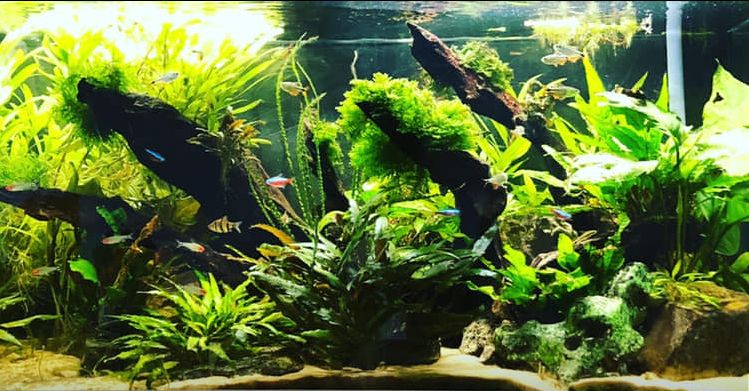
Planted Aquariums in Depth
We go into more guidelines for all aquariums more in this article:
15.1. Planted Aquariums in Depth
The following sections will give you some general guidelines on the easiest ways to set up a beautiful planted aquarium:
15.2. Fish for Planted Tank
15.3. Fish Limitations
15.4. Types of Planted Aquariums
15.5. Fertilizing
15.5.1. Ready-Made Fertilizer
15.5.2. Fertilizer Programs
15.5.3. Estimative Index
15.5.4. NH4 + Tabs Fertilizer
15.5.5. DIY Epiphytic Fertilizer
15.5.6. Fish Food as Fertilizer
15.5.7. DIY Fertilization
15.6. Carbon Dioxide
15.6.1. Low Tech CO2 Aquarium System
15.6.2. KH, pH, CO2 Relationships in a Planted Aquarium
15.6.3. High Tech CO2 System
15.6.4. CO2 from Food
15.7. Substrates for Planted Aquariums
15.8. Walstad Aquarium
15.9. High-Tech Planted Aquarium
15.10. Hybrid Planted Aquariums
15.11. Many Fish Many Plants
15.12. Propagating Plants
15.13. Hau Aquariums
15.14. Low Tech Planted Aquariums
15.15. Sterilizing Plants
15.16. “Natural” or “Balanced” Aquariums
15.17. Father Fish Aquariums
2.15. Cycling a Planted Aquarium
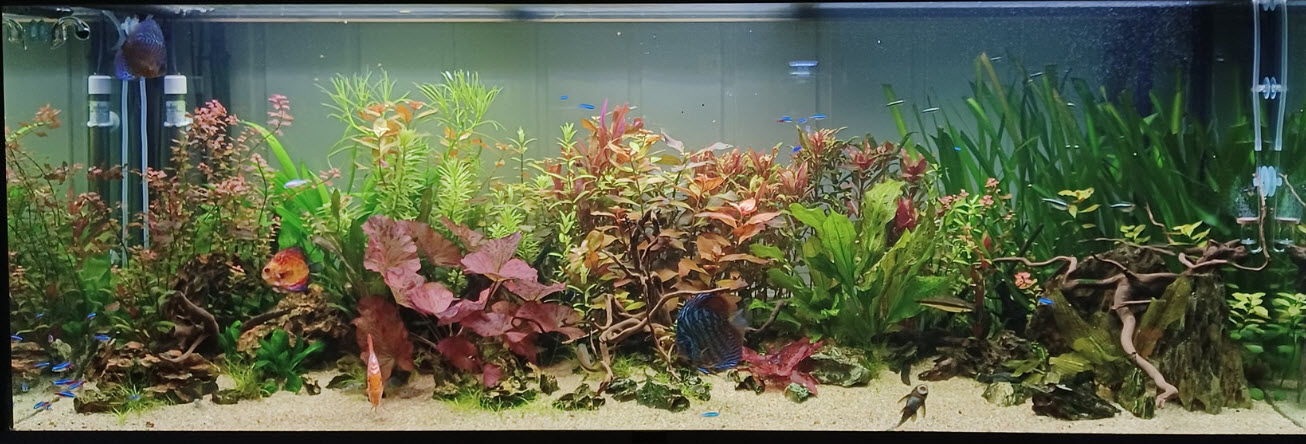
Types of Planted Aquariums
There are as many types of planted aquariums as there are hobbyists with planted aquariums. Each tank is different. But there are six broad categories of tanks. Three are “Natural” systems with no chemical fertilization or carbon dioxide gas (CO2 gas injection) to speak of. The conditions TYPICALLY seen in these three types of aquariums are as follows:
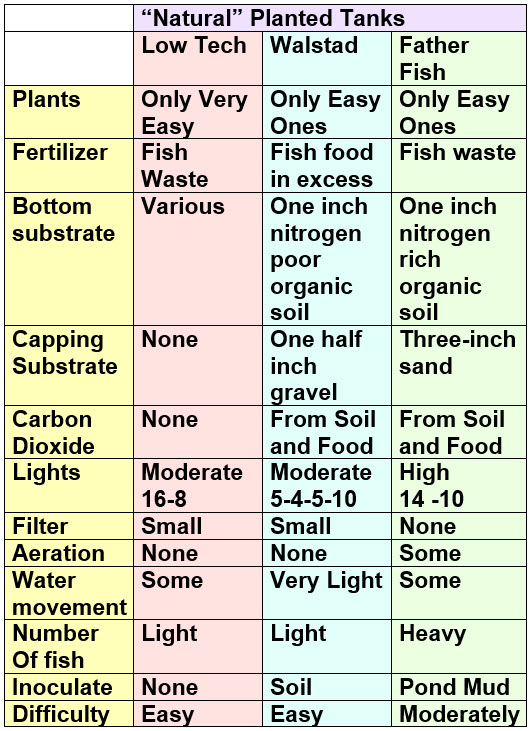
The following conventions are used for the lights. The “moderate” and “high” refer to the intensity of the light. The first number is hours on, second number is hours off, third number is hours on, etc.
Note the are NOT RULES. They are ONLY suggestions about what is seen in the typical aquarium of any given type. For instance, some of these low tech tanks have some very difficult plants growing quite well in them. The article on Walstad method has quite a few photos of Walstad aquariums with some very difficult plants in them. It just isn’t typical of the low tech type of aquarium. The aquarium is a natural system and Mother Nature is VERY flexible.
Then there are those planted aquarium systems which use chemical fertilization and/or carbon dioxide gas injection:
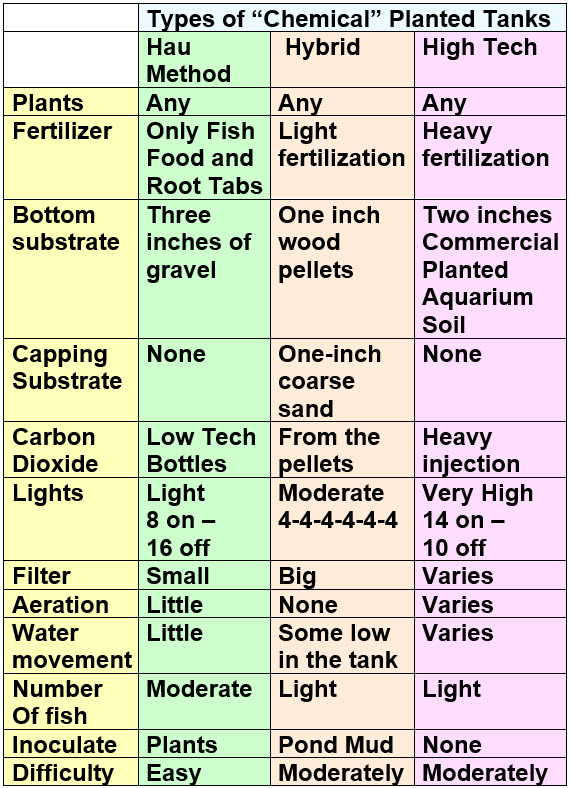
The following conventions are used for the lights. The “light”, “moderate” and “high” refer to the intensity of the light. The first number is hours on, second number is hours off, third number is hours on, etc.
Recommendations
It is POSSIBLE to have a successful planted aquariums which is a very simple affair without carbon dioxide additions and pretty much ANY combination of substrates, plants, aeration and filtration. I have only noticed one “guideline” with planted aquariums that is VERY challenging to break. This one “guideline” is:
.
Only have a Few Small Fish in the Planted Aquarium
.
Any experienced aquarium owner will tell you that when you enter the hobby there is a decision you must make. Do you want an aquarium of all fish or do you want an aquarium of largely plants? Do you want a fish aquarium or a planted aquarium? Creating a well planted aquarium with a heavy loading of fish is extremely difficult. Even a moderate amount of fish with a lot of plants is challenging. But then many enjoy a challenge.
In our meanderings over the years we have found several ways to have decent numbers of decent sized fish in an aquarium. Mother Nature is VERY flexible. These methods are reviewed in this link:
15.11. Many Fish Many Plants

If one really wants plants with their fish there are some plants which are the exception and simply can’t be killed and which seem to live under any and all conditions. While they will get some algae on their leaves the leaves are resistant to being smothered by algae. And they seem to live in under all conditions with no fertilizer at all. They even live with very low light conditions.
These plants include Anubias (just don’t put the bulbs INTO the substrate), Amazon Sword (Echinodorus amazonicus), Java Fern (Leptochilus pteropus, synonym Microsorum pteropus), and Java Moss (Taxiphyllum barbieri). Java fern and Java moss are both “epiphytes” and need to be either attached to a surface like a piece of wood or they need a very open substrate like aquarium gravel. If you bury the crown on Java fern in sand it will die.
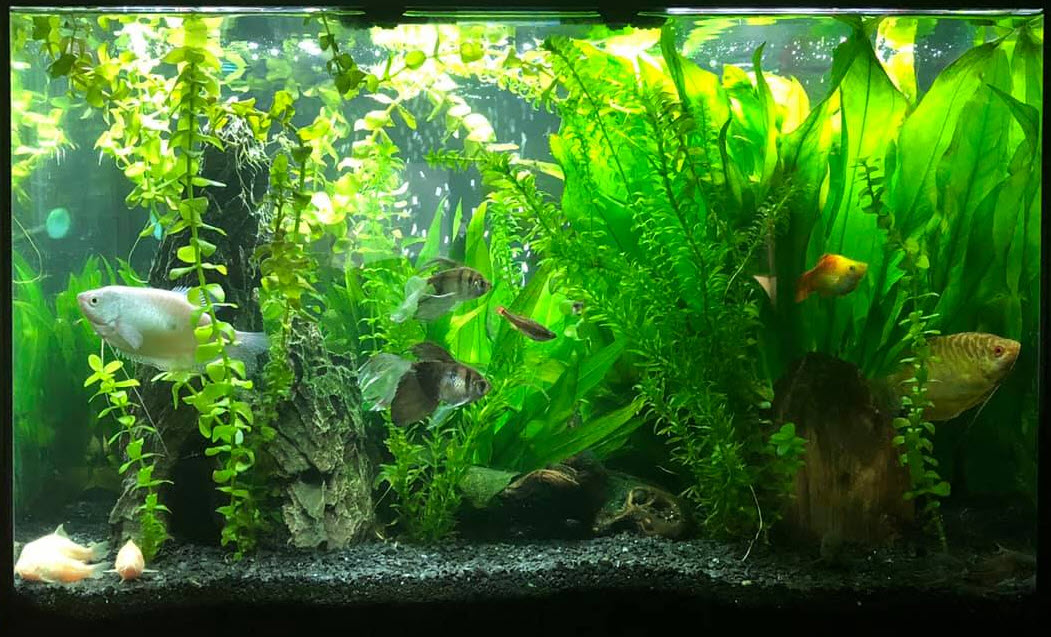
Definition of a “Planted Aquarium”
There is a distinct difference between a “planted aquarium” and an “aquarium with plants”. Beginners seem to think that one can put a few plants into an aquarium and within months the plants will multiply and take over the aquarium. It doesn’t work that way.
The aquarium below is one such aquarium. Note that the aluminum plant in the middle is terrestrial and will die in water. The other five species of plants will probably fare little better as there is an air stone operated sponge filter in the back. Air stones insure that the CO2 level is too low for most plants to survive.

For an example of how not to set up a planted aquarium, let’s use a sixty-gallon beginner’s “aquarium with plants”. Let us add six different species of plants into a sixty gallon aquarium at a density of one plant per ten gallons, six plants in the sixty gallon. This is what one would term “an aquarium with plants”. Of the six plants in our example, two die back in the first month to stubs, two do nothing and two begin growing slowly.
The beginner is adding the recommended dose of a complete fertilizer twice a week, just like the directions say. They leave the light on from 7 in the morning till ten at night (15 hours). Because they are way over fertilized the two stubs and the two plants doing nothing die completely.
And the two plants remaining struggle because they are getting the fertilizer loading for about fifty plants and algae are thriving in the high light condition. Finally all the plants die, algae takes over the aquarium and the hobbyist is puzzled as to what happened. After all, “I fertilized per the directions“.
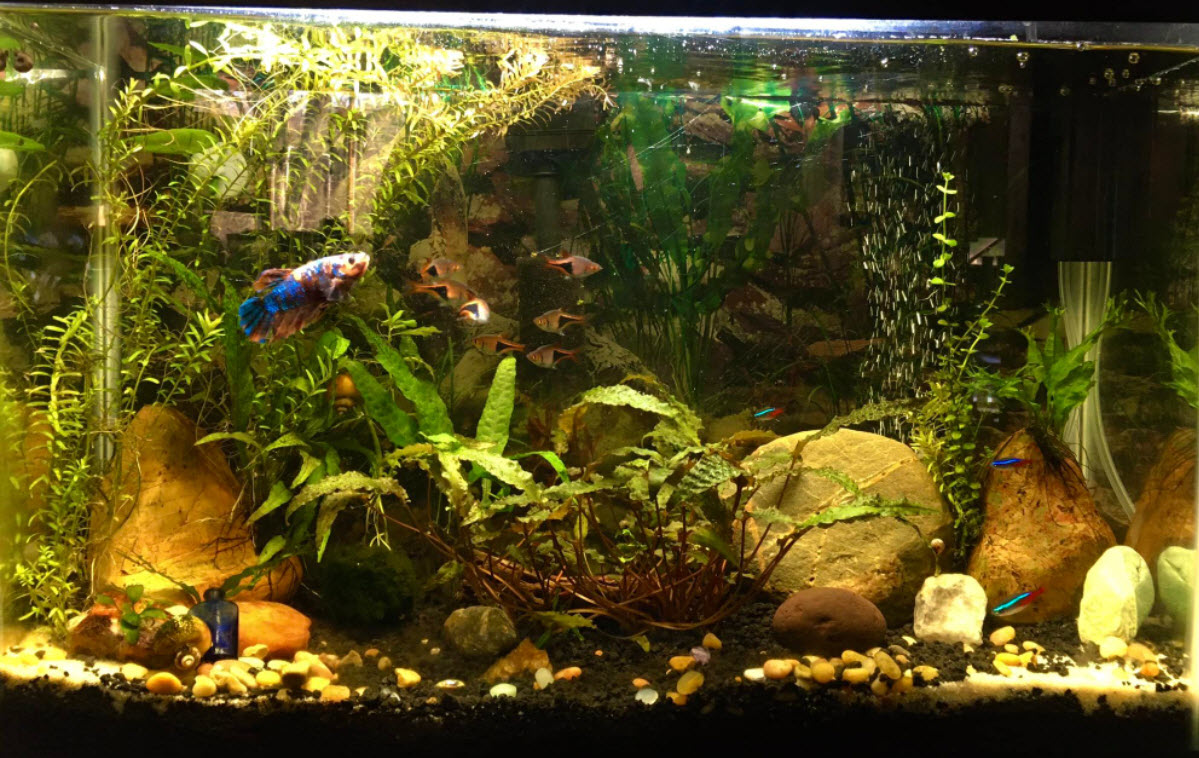
Experienced hobbyists who put together the beautiful high tech planted aquariums which are wall to wall with plants all either raise or buy plants in large quantities. They would plant this sixty-gallon aquarium with TEN plants of each species, sixty plants total. They would slowly ramp up the fertilizer along with the lighting over the span of a few months. They would NOT add any aeration. They would add some sort of CO2 (including soil substrate) to bring the CO2 level from 3 ppm to at least 10 ppm. This is a “planted aquarium”.
If one only has a limited budget and cannot buy sixty plants at once (at $5 per plant that is $300) one can raise the plants. But note that takes some thought. Here is a link on how to do it:
15.12. Propagating Plants
.
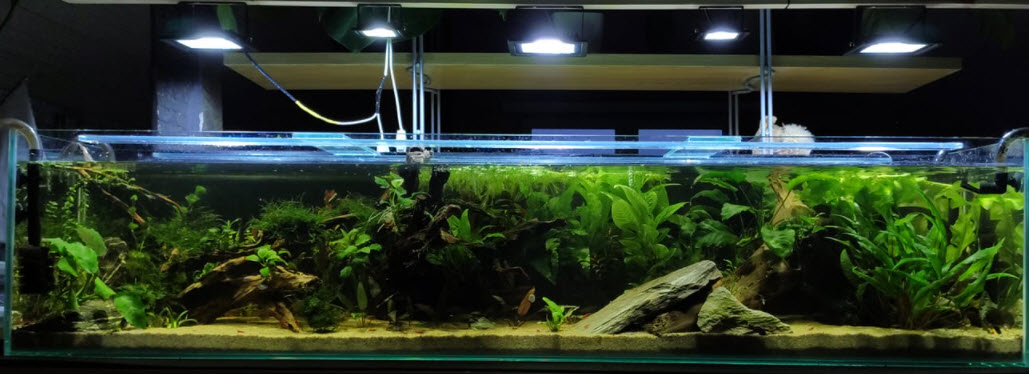
Recommendations for Planted Aquarium
There are several very general, frequently not followed, recommendations for a planted aquarium:
- Light stocking of fish smaller than two inches
- A carbon dioxide (“CO2”) level above 10 ppm first thing in the morning
- A plant every three inches across both the length and the width of the aquarium
- Little surface movement of the water and no air stones
- Slowly ramp up light and CO2 over a span of months.
Note that fertilization is NOT included in this list. Fertilization is MUCH less important than many seem to think.
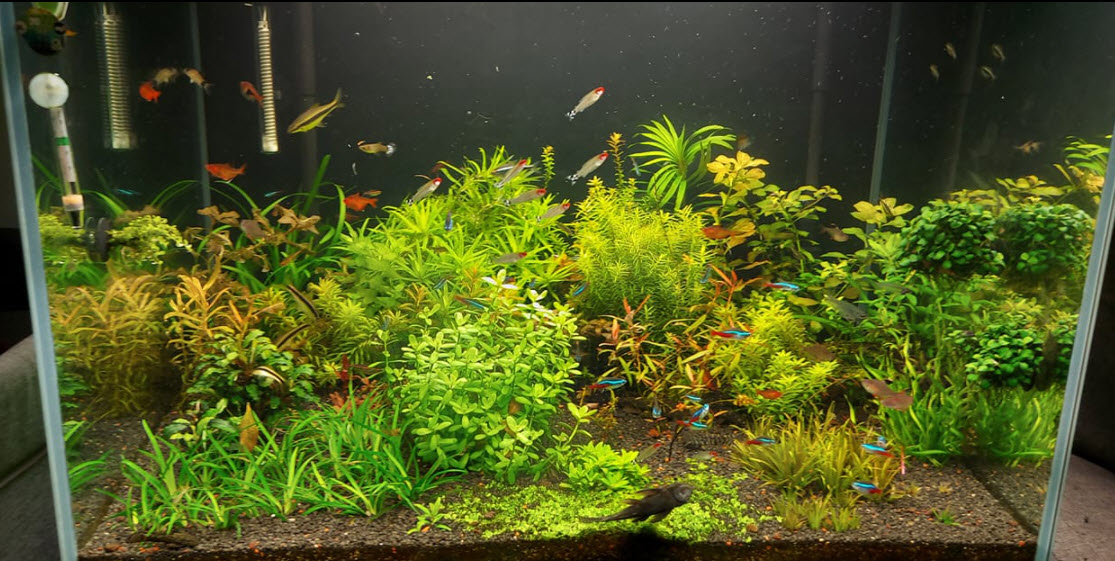
.
Return to Home Page and Main Menu
.
Aquarium Science Website
The chapters shown below or on the right side in maroon lead to close to 400 articles on all aspects of keeping a freshwater aquarium. These articles have NO links to profit making sites and are thus unbiased in their recommendations, unlike all the for-profit sites you will find with Google. Bookmark and browse!
.

Alex Powell says
Hi Dave,
I had a look in the Father Fish discord, and they are now recommending over filtration. The guides that they have set up are actually screenshots from this site – so well done on converting them with your accurate knowledge.
Unfortunately the discord has a “no advice” rule, and I was banned after answering how to calculate the volume of an aquarium. Oh well.
Confused fish keeper says
Thank You so much for helping explain the fish/ plant conundrum. I’ve happily and successfully kept fish for 50 yrs. I’ve recently been struggling with trying to balance “natural” aquariums. Trying to emulate popular videos on you tube. I’m spending a small fortune and tons of time and energy, only to feel guilty and wonder what I’m doing wrong, because I’ve lost so many fish and my plants are struggling. I Have a medium planted 75 gal with 1- 6″ Shubunkin, 2- 6″ veil Angel and 3- 2″ clown loach. The large fish in the 75 gal are territorial. Also have 32 gal medium planted with 1- 3″ fantail, 2- 2″ veil Angel, 5 corys, 5 Black Neon, 5 Sparkling Gourami, 5 White Cloud. I see now that the 32 gal is heavily stocked. I’ve just switched both from under gravel to only 1/2″ of sand. both have aeration and cannister filters. ANY suggestions/ comments would be helpful.
cliff says
What is the best way to root feed with sand substrate? root tabs fro seachem and api are not working
Anonymous says
1
Dave says
In reply to JON …. Fully aerated water will have two to three parts per million CO2 in it.
JON says
Hi, I only took Chemistry in highschool and 1st year in college so know very little about it.
Plain air has about 400ppm of CO2 in it. What will the ppm in water be if you aerate plain air into water? will it still be only 3ppm of CO2 in water?
I am just curious if aeration will really lower the CO2 level in the water when the only CO2 source is some few fishes in a low tech, walstead or fatherfish tank.
Dave says
In reply to Tom …. You make a good point A “pure” low tech low stocking tank might well benefit from starting a period of aeration after a period of lighting has decreased the CO2 below 3 ppm.
Tom says
On most of the planted aquarium types discussed here, various mechanisms are used to raise CO2 above 3 ppm (that is, above equilibrium with surrounding air), so any aeration will drive CO2 undesirably down toward 3 ppm. Minimizing aeration therefore helps the tank retain the excess CO2. I’m struggling on why you’d want to minimize aeration in the low-tech planted aquarium. In a low-tech aquarium, the only source of CO2 is respiration. Following the above recommendations on lightly stocking fish, I’d expect photosynthesis would consume CO2 faster than respiration would generate it. Therefore, with the lights on, CO2 will plummet below 3 ppm equilibrium. Wouldn’t maximizing aeration help replenish CO2 back toward 3 ppm? Obviously 3 ppm CO2 isn’t much, but isn’t that the strategy of the low-tech aquarium?
Dave says
In reply to anonymous …… Yes. A ton of driftwood would decompose, producing CO2.
Anonymous says
Would putting a ton of driftwood in the aquarium work as well to put Co2 into the water?